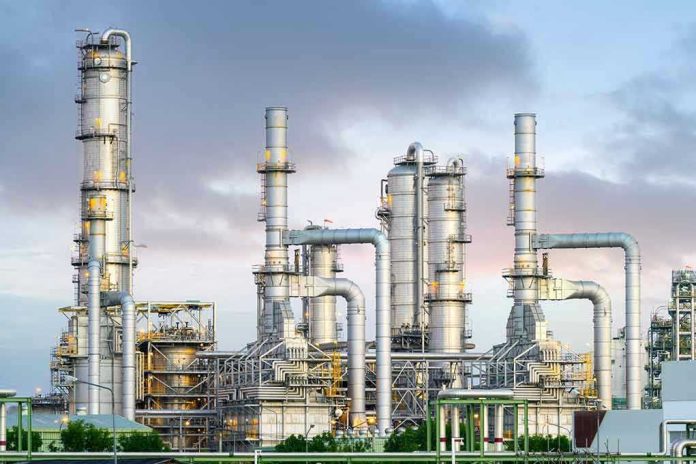
A single tanker truck parked in a hotel lot unleashed a toxic cloud that hospitalized 36 people and forced hundreds from their homes in what became Oklahoma’s latest hazardous material nightmare.
Story Snapshot
- Anhydrous ammonia leak from tanker truck in Weatherford, Oklahoma hospitalized 36 people on November 12, 2025
- Hundreds evacuated as toxic gas plume spread through populated area near Interstate 40
- Oklahoma National Guard and hazmat teams deployed for emergency containment and air quality monitoring
- Schools, nursing homes, and businesses closed while 500-600 residents sought shelter overnight
When Routine Transport Turns Deadly
The nightmare began around 10 p.m. when a tanker truck carrying anhydrous ammonia developed a leak while parked at a hotel in Weatherford, a farming community of 12,000 people located 70 miles west of Oklahoma City. The agricultural chemical, commonly used as fertilizer, immediately began forming a dangerous gas plume that spread rapidly through the surrounding area.
Emergency responders faced a perfect storm of dangers. Anhydrous ammonia causes severe burns and respiratory distress upon contact, and the lack of wind that night prevented the toxic gas from dissipating naturally. What should have been a routine overnight stop became a mass casualty event requiring military intervention.
The Human Cost of Chemical Transport
Within hours, local hospitals were overwhelmed with patients suffering from chemical exposure. At least 36 people required hospitalization, with 11 transferred to facilities outside the immediate area for specialized treatment. The victims experienced respiratory distress, chemical burns, and other complications from breathing the toxic fumes that had blanketed their community.
Vulnerable populations bore the brunt of the disaster. Nursing homes evacuated elderly residents in the middle of the night, while families with children scrambled to find safe shelter. The randomness of the incident – a truck leak in a hotel parking lot – meant no one had advance warning or time to prepare protective measures.
Emergency Response Reveals System Strengths and Gaps
Credit belongs to first responders who mobilized quickly despite the scale of the emergency. Hazmat teams, local emergency services, and the Oklahoma National Guard coordinated evacuations and established shelters for the displaced residents. By morning, 500 to 600 people had sought refuge in emergency facilities while air quality monitoring continued around the clock.
Hundreds evacuated and dozens hospitalized after an ammonia gas leak in Oklahomahttps://t.co/NIwmnwDWwD
— Toronto Star (@TorontoStar) November 13, 2025
However, the incident exposed concerning vulnerabilities in hazardous material transport. A single truck carrying agricultural chemicals through populated areas created a disaster requiring military intervention and mass evacuations. The Interstate 40 exit remained closed, disrupting commerce and travel while authorities waited for air quality to improve sufficiently for residents to return home safely.
Questions That Demand Answers
This Oklahoma disaster follows a troubling pattern of recent ammonia-related incidents, including a plant explosion in Mississippi just one week earlier. The frequency of these events raises serious questions about oversight, safety protocols, and route planning for hazardous material transport through American communities.
Common sense suggests that trucks carrying chemicals capable of hospitalizing dozens and displacing hundreds deserve more rigorous safety measures than currently exist. While agriculture depends on ammonia fertilizer, communities deserve protection from the catastrophic risks posed by routine chemical transport through populated areas. The Weatherford incident proves that current safety protocols are inadequate for protecting American families from preventable disasters.
Sources:
Arab News: Hundreds evacuated and dozens hospitalized after an ammonia gas leak in Oklahoma
iHeartRadio: Dozens Hospitalized In Oklahoma After An Ammonia Gas Leak







